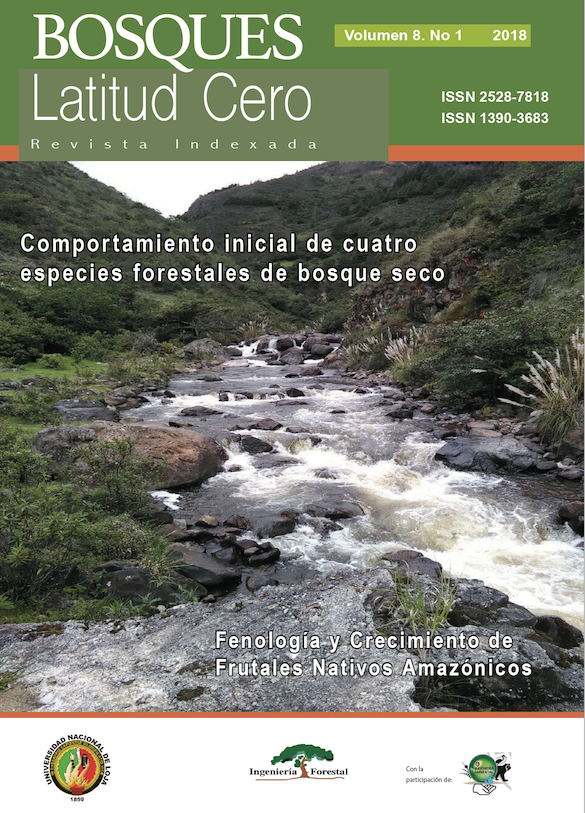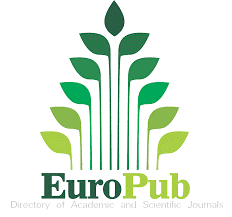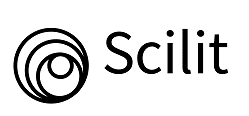Index of phenological activity of ten Amazonian fruit species in the El Padmi Experimental Station, Zamora Chinchipe, Ecuador
Keywords:
indicators, patterns, dynamics, standardizationAbstract
Understanding how natural phenomena are governed and associated with their variables has been a priority for the human being; its understanding has allowed the environment to be modi-fied, maintained and even improved. This study tries to estimate the phenological activity of ten Amazonian fruit species during a year, through a weighted index that includes standardized values of flowering, fruiting and increase of stem volume. The phenological activity index allowed to identify and describe (I) an isolated pattern showing four species with unique or uncommon events and (II) a grouped pattern, with two subgroups of three species each, showing common events and in synchrony with events from other locations. The information generated can contribute to the knowledge and exploitation of non-traditional fruit species in the Amazon region of southern Ecuador.References
Agea, J. G., Obua, J., Kaboggoza, J. R., & Waiswa, D. (2007). Diversity of indigenous fruit trees in the traditional cotton-millet farming system: the case of Adwari subcounty, Lira district, Uganda. African Journal of Ecology, 39–43.
Aguirre Mendoza, Z., & León Abad, N. (2011). Sobrevivencia y crecimiento inicial de especies vegetales en el Jardin Botanico de la quinta El Padmi, Zamora, Chinchipe. Arnaldoa, 115 - 122.
Aguirre Mendoza, Z., Díaz Ordóñez, L. F., & Palacios H., B. (2015). Fenología de especies forestales nativas en el Jardín Botánico El Padmi, Zamora Chinchipe, Ecuador. Cedamaz, 68-80.
Aguirre Mendoza, Z., Gaona Ochoa, T., & Placios Herrera, B. (2014a). Dinámica de crecimiento de especies forestales establecidas en el Jardín Botánico El Padmi, Zamora Chinchipe, Ecuador. Cedamaz, 62-75.
Aguirre Mendoza, Z., Palacios Herrera, B., & Aguirre, N. (2014b). Dinámica de crecimiento y fenología de un ensamble de especies forestales establecidas en el jardín botánico El Padmi, Zamora Chinchipe. Cascarilla, 18-22.
Alfia, M., Vasugi, C., Honnabyraiah, M., Adiga, J., Shivapriya, M., & Vincen, L. (2017). Phenological stages of wild species and cultivated species of guava (Psidium guajava L.). Int. J. Pure App. Biosci., 464-474.
Alvarez, G. (2014). Caracterización y potencial de uso de especies frutales nativas en la región sur de la amazonía ecuatoriana. Cedamaz, 54-62.
Alves-Araújo, A., Swenson, U., & Alves, M. (2014). A Taxonomic Survey of Pouteria (Sapotaceae) from the Northern Portion of the Atlantic Rainforest of Brazil. Systematic Botany, 915–938.
Cañadas, L. (1983). El Mapa Bioclimático y Ecológico del Ecuador. Quito: PRONAREG.
Dallmeier, F. (Ed.). (1992). Long-term monitoring of biological diversity in tropical forest areas: methods for establishment and inventory of permanents plots. Paris: UNESCO.
Davis, C. C., Willis, C. G., Primack, R. B., & Miller-Rushing, A. J. (2010). The importance of phylogeny to the study of phenological response to global climate change. Phil. Trans. R. Soc. B, 3201–3213.
Escobar, C., Zuluaga, J., Cardenas, C., & Rivas, E. (1999). El cultivo de araza (Eugenia stipitata McVaugh) (Segunda ed.). Colombia: Corpoica Regional 10.
Falcão, M. d., & Clement, C. R. (1999). Fenología e produtividade do abiu (Pouteria caimito) NA AMAZÔNIA CENTRAL. ACTA AMAZONICA, 3-11.
Falcão, M. d., & Clement, C. R. (2000). Fenologia e produtividade do Infá-Cipó (Inga edulis) na Amazônia Central. Acta Amazonica, 173-180.
Falcão, M. d., & Lleras, E. (1980). Aspectos fenológicos, ecológicos e de produtividade do Mapati (Pourouma cecropiifolia Mart.) . Acta Amazonica, 711-724.
Falcão, M. d., & Lleras, E. (1983). Aspectos fenológicos, ecológicos e de produtividade do cupuaçu-Theobroma grandiflorum (Willd. ex Spreng.) Schum. Acta Amazonica, 725-735.
Falcão, M. d., Lleras, E., Kerr, W. E., & Medeiros Carreira, L. M. (1981). Aspectos fenológicos, ecológicos e de produtividade do biribá (Rollinia mucosa ( Jacq.) Baill.). Acta Amazonica, 297-306.
Falcão, M. d., Paraluppi, N. D., & Clement, C. R. (2002). Fenologia ε produtividade do jambo (Syzygium malaccensis) NA AMAZÔNIA CENTRAL. ACTA AMAZÓNICA, 3-8.
Falcão, M., Clement, C., Moreira Gomes, J. B., Chávez Flores, W., Santiago, F. F., & Freitas, V. P. (2001). Fenologia e produtividade da fruta-pão (Artocarpus Altilis) e da Jaca (A. heterophyllus) na Amazônia Central. Acta Amazonica, 179-191.
Fournier, L. (1974). Un método cuantitativo para la medición de características fenológicas en árboles. Turrialba, 422-423.
Giraldo, C. I., Rengifo, L., Aguilar, E., Gaviria, D., & Alegría, Á. H. (2004). Determinación del sexo en borojó (Borojoa patinoi, Cuatrecasas) mediante marcadores moleculares. Revista Colombiana de Biotecnología, 9-14.
Guitton, H. (1960). Índices e indicadores. Revista de Economía y Estadística, 9-23.
Kanten, R. v., & Beer, J. (2005). Production and phenology of the fruit shrub Eugenia stipitata in agroforestry systems in Costa Rica. Agroforestry Systems, 203–209.
Marín-Gómez, O. H., Castaño, A. F., & Gómez, G. D. (2012). Fenología del guamo Inga edulis (FABALES: MIMOSOIDEAE) en dos agrosistemas del Quindío, COLOMBIA. Revista de Investigaciones - Universidad del Quindío, 127-133.
Martel, C. (2012). Una nota adicional sobre la polinización en Rollinia mucosa (Jacq.) Baill., “La Anona’’, en el sureste del Perú. Xilema, 88-93.
Moneruzzaman Khandaker, M., Nasrulhaq Boyce, A., Osman, N., & Sharif Hossain, A. (2012). Physiochemical and Phytochemical Properties of Wax Apple (Syzygium samarangense [Blume] Merrill & L. M. Perry var. Jambu Madu) as Affected by Growth Regulator Application. The Scientific World Journal, 1-13.
Neita, J. C., Cortés, H., & Madrigal, A. (2004). Los himenópteros asociados a una parcela agroforestal de Borojao patinoi, Cedrela odorata, Apeiba aspera e Inga spectabilis en la granja de la Universidad del Chocó, municipio de Lloró, Chocó. Revista Colombiana de Entomología, 233-239.
Proença, C. E., Filer, D. L., Lenza, E., Silva, J. S., & Harris, S. A. (2012). Phenological Predictability Index in BRAHMS: a tool for herbarium-based phenological studies. Ecography, 289–293.
Ragone, D. (2006). Artocarpus altilis (breadfruit). Obtenido de https://ntbg.org/: http://pacificschoolserver.org/content/_public/Local%20Topics/Pacific%20Islands/Agriculture%20for%20Islands/Specialty%20crops/Traditional%20trees%20of%20Pacific%20Islands.pdf
Rocky Mountain Tree-Ring Research. (30 de Marzo de 2018). Rmtrr.org. Obtenido de http://www.rmtrr.org/oldlist.htm
Ruml, M., & Vulić, T. (2005). Importance of phenological observations and predictions in agriculture. Journal of Agricultural Sciences, 217-225.
Sánchez, D., Arends, E., Villarreal, A., & Cegarra, A. (2005). Fenologia y caracterizacion de semillas y plantulas de Pourouma cecropiifolia. ECOTROPICOS, 96-102.
Sierra, R. (1999). Propuesta preliminar de un sistema de clasificación de vegetación para el Ecuador continental. (R. Sierra, Ed.) Quito: Proyecto INEFAN/GEF-BIRF Y EcoCiencia.
Venturieri, G. A. (2011). Flowering levels, harvest season and yields of cupuassu (Theobroma grandiflorum). Acta Amazonica, 143 - 152.
Downloads
Published
How to Cite
Issue
Section
License
Copyright (c) 2018 Bosques Latitud Cero

This work is licensed under a Creative Commons Attribution-NonCommercial-ShareAlike 4.0 International License.
This work is published under the Creative Commons Attribution-NonCommercial-ShareAlike 4.0 International (CC BY-NC-SA 4.0) license. This means that users may copy, distribute, and adapt the content, provided that proper credit is given to the authors and the journal. Commercial use of the material is not permitted. Additionally, any derivative work must be distributed under the same license. This license ensures open access to knowledge, promoting the dissemination and reuse of published works for non-commercial purposes, respecting authorship, and ensuring the free circulation of content under fair terms.





























